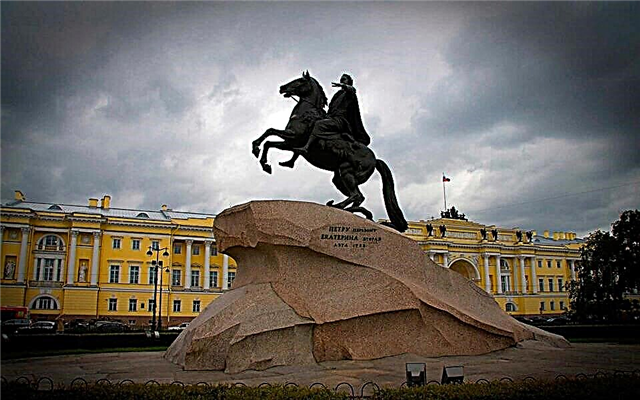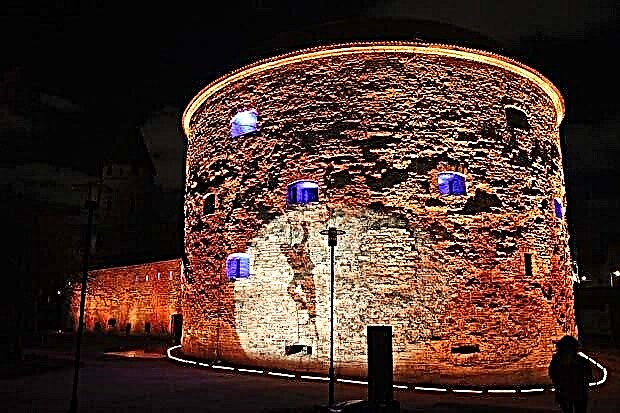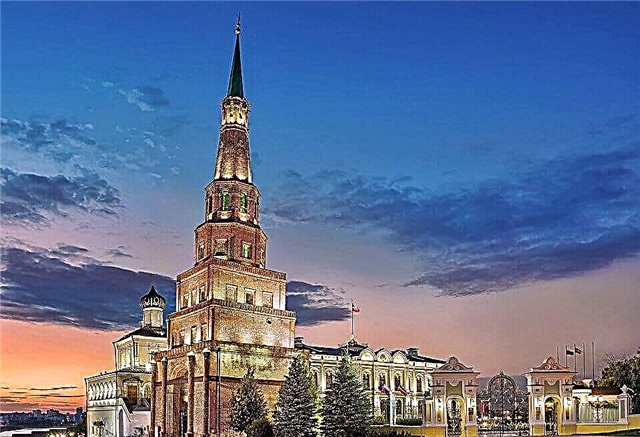The most romantic and unusual building in Tatarstan is located on the territory of the Kremlin. The Syuyumbike Tower in Kazan is a place that every guest of the city visits. It is surrounded by legends, fanned with love for its history. Tourists from central Russia at first will not find anything unusual in the building: perhaps it is very reminiscent of the Spasskaya Tower of the Moscow Kremlin. And after looking closely, they will feel the peculiar beauty of the structure. Heard legends, for which Kazan is rich, will complement the impressions received. Today the building is one of the symbols of Tatarstan. Tourists, inspired by mysteries and legends, buy souvenirs that depict the tower.
Construction history

The history of the tower's construction has more questions than answers. This is due to the fact that archival documents were destroyed during the capture of Kazan. Later plans and drawings burned down during the fire, so it is impossible to pinpoint the exact time of the monument's construction. You can operate with some data:
- The 1717 plan reflects this structure. This means that the leaning tower was built earlier.
- Adam Olearius visited Kazan in 1638. He studied the city in detail and made a plan: there is no tower on it. This means that it was built later.
- However, research carried out by archaeologists showed that the building was erected in the period from 1645 to 1650.
And there is no information about who designed the structure, whether it was built by order of local governors or the king himself.
Architecture

This structure resembles the Eiffel Tower in Paris: it is also the emblem of the capital, Kazan. At the same time, the building belongs to the type of falling towers, like the Leaning Tower. And it is quite difficult to unequivocally determine the architectural style: the traditions of Russian architecture are closely intertwined with Tatar motives. The main structural elements are described in detail by the researchers:
- The builders used oak pillars as a foundation. Over time, under the weight of the structure, they sank 2 meters.
- At that time they did not know cement: its role in fastening the bricks was played by lime mortar.
- The edges of the tiers are softened with red brick rollers. These structural elements prevent wind erosion.
- The lower 3 tiers are cubic in shape. There are gulbisches with loopholes arranged in them: this is a feature of Russian watchtowers. The next 4 have octagons in cross section. The last tier is a watchtower.
- The structure ends with a spire with a crescent, the emblem of Muslims. It is unlikely that he was at the time of construction.
- The size of the building is impressive: from ground level to the spire, 58 meters. For the estimated time of erection, the height is significant.
Tatar elements can be traced in ornaments, lattice weaving, decorative inserts. They favorably dilute the strict Moscow style.
Name

It is impossible to say unequivocally why the building was named that way. But in order to get closer to the truth, it is enough to investigate the known facts. The fall of Kazan in 1552 and the death of the khanate were followed by sad events:
- a ban on professing Islam: all mosques were destroyed, mullahs were forbidden to serve, and believers were forbidden to pray;
- the imposition of Orthodoxy and the requirement for the baptism of Muslims: the baptized Tatar received significant benefits when selling manufactured goods;
- this led to the fact that they began to confess Islam in secret: Orthodoxy was accepted only for show;
- settling the lands by the Orthodox: Ivan Vasilyevich ordered his nobles to relocate entire villages and villages to new places;
- the prohibition of Tatar artisans to directly sell goods: Tatars were forced to sell products of excellent quality to Russian merchants for a pittance;
- eviction of the Tatars who survived the assault on the shore of Lake Kaban (determination of the Pale of Settlement);
- removal of Tatar villages from busy roads and replacing them with Russian villages: the consequences of this measure are still noticeable, there are no Tatar settlements near the once busy highways.
But it is impossible to destroy the people's memory of historical events just like that: the legend about the heroic defense of Kazan and its defenders was passed from mouth to mouth. Probably, in subsequent years, when the governor settled in the Kremlin with the troops subordinate to him and rebuilt the building, and a fairy tale about the last queen Syuyumbika and the watch tower was invented.
Legends

The unusual structure has given rise to many legends:
- Ivan of Moscow decided to conquer Kazan, only hearing about the virtue and beauty of the regent Syuyumbike. But the proud widow refused the conqueror. As a result of a long siege, the city was captured. Syuyumbike had no choice: she agreed to become the wife of Ivan IV in order to stop the destruction of the khanate, but set a condition. The wedding gift should be a tower, a symbol of love for Ivan of Moscow. At her request, the Russian prince built a tower in 7 days. During the wedding feast, the young newlywed climbed to the last tier to take a last look at her beloved Kazan. There she turned into a beautiful swan and flew away from the conqueror.
- The virtuous Syuyumbike buried her husband, Safa-Girey, and erected a mausoleum, that is, a tower, over his grave. The building survived the siege of Kazan, and was later used as a watchtower.
- Soomyubike's virtue delighted her subjects. In gratitude, they built a watchtower at their own expense and presented it to their mistress.
- A romantic building makes wishes come true. True, you only need to ask for love. To make your wish come true, it is recommended to lean against the tower and think about the cherished.
- After the capture of Kazan, the Russians slightly changed and completed the lookout tower, which was located in the same place.
- There is a ball on the spire. Muslims of Tataria claimed that it was made of the purest gold. And most importantly: inside there are documents that are most important for the residents of the Volga region, which can "turn over" history.
Unfortunately, these are just beautiful legends. The widow of Safa-Gireya never met Ivan IV: some time before that she had been given as a wife to the Kasimov prince. There the former regent lived until her death: this fact is confirmed by the scribes. The basis for the second tale was the fact that a year before the last assault on Kazan, the ambassadors, the seid Kul-Sharif and the Tyumen prince Birbas, proposed that the regent and his young son be taken hostage. The diplomats believed that the royal prisoners should be the guarantee of peace for the Kazan Khanate and the Moscow state. Ivan Vasilievich refused.
The merits of the last queen of the Kazan Khanate are not in doubt. But there is no evidence that the tower was built during her reign. Tourists are invited to check for themselves to what extent the tower fulfills what they wish. And the fact that the remains of the Kazan Khan are buried under the tower is refuted by the archaeological research carried out. It is impossible to prove or disprove the penultimate statement: no documents are available. In addition, it is rather strange that a separate building survived when everything inside the Kremlin was burned and destroyed.
And the last legend was debunked quite easily. In the 70s of the twentieth century, the intensity of passions turned out to be so strong that the city authorities decided to open the mysterious ball. In the presence of Muslim elders, it was carefully removed and sawed off. Inside, it turned out to be empty, and the material from which the apple is made is brass. But then a new legend was born: the most important documents were stolen and hidden so that justice would never triumph. Well, the mysterious structure continues to amaze!
Mansion on Teatralnaya
Kazan
In a few minutes you can walk to Bauman Street and the Kazan Kremlin

Hotel Nogai
Kazan
300 meters from the Peter and Paul Cathedral

DoubleTree by Hilton Kazan
Kazan
5 minutes walk from the Kazan Kremlin

Interesting Facts

There are many unusual things around the most famous tower of Tatarstan:
- The structure has a strong eastward slope. This is the only leaning tower on the territory of not only Tatarstan, but also Russia.
- Archaeologists claim that a watchtower was previously built on this site. It was used by the Tatars to defend the fortress.
- A similar structure can be found in the ensemble of the Kazan railway station in Moscow: the architect Shchusev used some motives.
- For the first time, the building is indicated on the architectural plan of 1717. Perhaps it was present in earlier drawings that burned down during a fire.
- A construction error caused the tower to tilt. But in 1930, a frame was brought under the first tier: this stopped the destructive process for a while, the tower stopped falling.
- Today the slope is 198 cm. Re-strengthening works were carried out in the 80s of the last century.
- The 4 upper tiers have an octagon in cross section: this way the builders saved up to 20% of bricks and mortar and at the same time reduced the wind load on the structure.
- It is unlikely that the crescent that crowns the spire was in its place at the time of Ivan of Moscow: then all the symbols of Muslims were eradicated.
- Currently, the pearl of Tatarstan is very popular: souvenirs, mugs with its image and a coloring book for children are sold.
Tourists love to walk near the mysterious tower. It is especially beautiful at night, when green lamps illuminate it. It was at this time that the angle of inclination of the falling structure can be estimated.
Where is it located and how to get there
The tower is located on the territory of the Kazan Kremlin architectural reserve. Its address is 420111, Kazan, Kremlin. You can independently take the metro to the Kremlevskaya station, then walk to the entrance. If desired, it is easy to get there by ground transport: buses 6, 15, 29, 35, 35a, 37, 47, 74, 74a, 75 will take the guest to the stops "TSUM", "Central Stadium", "Palace of Sports".











